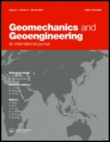
Geomechanics and Geoengineering-An International Journal
Scope & Guideline
Fostering Collaboration in Engineering Geology
Introduction
Aims and Scopes
- Geotechnical Analysis and Design:
The journal emphasizes the importance of rigorous geotechnical analysis and design methodologies, including numerical and experimental approaches, to address complex engineering challenges in soil-structure interaction, foundation design, and slope stability. - Sustainable Engineering Practices:
A core area of focus is the development and use of sustainable engineering practices, including the stabilization of soils using recycled materials, bioengineering techniques, and the evaluation of alternative materials for construction. - Seismic and Dynamic Analysis:
Research published in the journal often explores the seismic behavior of soil and structures, including liquefaction potential, dynamic response under seismic loading, and the interactions between structures and their foundation soils. - Innovative Materials and Techniques:
The journal showcases studies on innovative materials and techniques in geotechnical engineering, such as the use of geosynthetics, fiber reinforcement, and advanced modeling techniques to improve soil properties and construction practices. - Environmental Geomechanics:
Research on the environmental aspects of geomechanics, including the impact of contaminants on soil behavior and the role of geotechnical engineering in sustainable environmental practices, is a significant focus area.
Trending and Emerging
- Machine Learning and AI Applications:
An increasing number of papers are exploring the application of machine learning and artificial intelligence techniques to predict soil behavior and optimize geotechnical designs, highlighting a trend towards data-driven analysis in geomechanics. - Use of Recycled and Sustainable Materials:
There is a growing emphasis on the use of recycled materials and sustainable practices in geotechnical engineering, with studies focusing on the performance of materials such as rubber, plastic, and industrial by-products for soil stabilization and construction. - Advanced Numerical Modeling Techniques:
The trend towards employing advanced numerical modeling techniques, including finite element analysis and discrete element modeling, is evident in recent publications, as researchers seek to improve the accuracy and reliability of geotechnical predictions. - Geotechnical Risk Assessment and Management:
Emerging themes in geotechnical risk assessment and management are gaining traction, with research focusing on probabilistic approaches and the integration of geotechnical data into broader risk management frameworks. - Impact of Climate Change on Geotechnical Engineering:
Recent studies are increasingly addressing the impact of climate change on geotechnical engineering practices, including the effects of extreme weather events on soil stability and foundation performance.
Declining or Waning
- Traditional Soil Mechanics:
There has been a noticeable decline in papers focusing on traditional soil mechanics principles without integration into modern applications or technologies, as the field evolves to incorporate more advanced analytical and computational methods. - Static Analysis Techniques:
Research centered on purely static analysis techniques, such as conventional limit equilibrium methods, appears to be waning in favor of dynamic analysis and real-time modeling approaches that better capture the complexities of modern geotechnical challenges. - Basic Laboratory Testing Methods:
The frequency of studies solely relying on basic laboratory tests (e.g., triaxial tests without advanced analysis) has decreased, as there is a growing trend towards integrating these tests with numerical modeling and artificial intelligence for predictive analysis.
Similar Journals
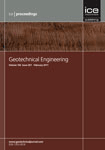
PROCEEDINGS OF THE INSTITUTION OF CIVIL ENGINEERS-GEOTECHNICAL ENGINEERING
Connecting Theory and Practice in Geotechnical InnovationsPROCEEDINGS OF THE INSTITUTION OF CIVIL ENGINEERS-GEOTECHNICAL ENGINEERING, published by Emerald Group Publishing Ltd, is a prestigious journal that serves the dynamic field of geotechnical engineering and broader earth sciences. With an ISSN of 1353-2618 and an E-ISSN of 1751-8563, this journal has established itself as a vital resource for researchers, professionals, and students alike, offering insights into innovative practices and developments within the geotechnical domain. It ranks within the Q2 category for Earth and Planetary Sciences and Geotechnical Engineering as of 2023, demonstrating its significant impact and relevance in these fields. Given its comprehensive scope from 1994 to 2024, the journal provides a platform for high-quality research articles, case studies, and technical notes, although it presently does not offer open access options. Researchers seeking to publish their work will find this journal an essential venue for reaching an audience deeply invested in the advancement of geotechnical methodologies and solutions.
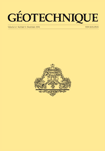
GEOTECHNIQUE
Leading the Way in Geotechnical Research and ApplicationGEOTECHNIQUE is a prestigious peer-reviewed journal published by Emerald Group Publishing Ltd, specializing in the fields of Geotechnical Engineering and Earth and Planetary Sciences. Established in 1948, this journal has consistently delivered groundbreaking research and advancements in the science of soil and rock mechanics, engineering geology, and environmental applications, aiming to foster innovation in geotechnical practices. With an impressive impact factor reflected in its Q1 ranking within both the Earth and Planetary Sciences and Geotechnical Engineering categories, GEOTECHNIQUE is recognized as a leading source of scholarly articles, positioning itself among the top 5% in the field. The journal is accessible via subscription, providing a repository of invaluable insights for researchers, professionals, and students striving to push the boundaries of knowledge and application in geotechnical topics. With a robust editorial board and a commitment to excellence, GEOTECHNIQUE continues to contribute significantly to the academic community and the practical engineering landscape.
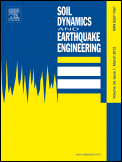
SOIL DYNAMICS AND EARTHQUAKE ENGINEERING
Elevating Standards in Geotechnical and Structural Engineering ResearchSOIL DYNAMICS AND EARTHQUAKE ENGINEERING is a premier academic journal published by ELSEVIER SCI LTD, focusing on the intersection of civil and structural engineering, geotechnical engineering, and soil science. Since its inception in 1986, the journal has established itself as a critical resource for advancing knowledge in these fields over nearly four decades, with a remarkable Q1 ranking in 2023 across multiple categories, including Civil and Structural Engineering, Geotechnical Engineering, and Soil Science. The journal’s impactful research, reflected in its high Scopus ranks, serves as a vital reference for both professionals and academics dedicated to understanding soil dynamics and mitigating earthquake hazards. Although it currently does not offer open access, the journal's rigorous peer-review process ensures that published articles provide substantial contributions to the understanding of soil behavior under seismic conditions. Whether you are a researcher, a practitioner, or a student, SOIL DYNAMICS AND EARTHQUAKE ENGINEERING offers essential insights and innovative methodologies pivotal for advancing your work in soil dynamics and earthquake engineering.

Soil Mechanics and Foundation Engineering
Exploring the Depths of Soil Behavior and DesignSoil Mechanics and Foundation Engineering, published by SPRINGER, is a prestigious academic journal dedicated to the dynamic fields of soil mechanics and foundation engineering. With a history spanning from 1964 to 2024, this journal serves as a vital platform for researchers, professionals, and students looking to advance their knowledge and explore innovative techniques in soil behavior, foundation design, and geotechnical engineering. Although the journal does not currently operate under an open access model, it remains essential for its contributions to key disciplines, notably in energy, geotechnical engineering, ocean engineering, soil science, and water science. Positioning itself in the third quartile of various categories in the 2023 rankings, it reflects a commitment to maintaining rigorous research standards despite its competitive environment. The unique intersection of its scope allows for multidisciplinary collaboration, making it an invaluable resource for those aiming to tackle the challenges in foundation systems and soil interactions in diverse engineering applications.
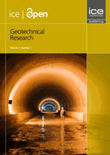
Geotechnical Research
Driving forward the frontiers of geotechnical research.Geotechnical Research is an esteemed scholarly journal published by EMERALD GROUP PUBLISHING LTD, dedicated to advancing the field of geotechnical engineering and earth sciences. With an impact factor reflective of its robust contributions, this open access journal has been providing unrestricted access to high-quality research since 2014, making it indispensable for researchers, professionals, and students alike. The journal, indexed under the ISSN 2052-6156, features rigorous peer-reviewed articles that encompass a wide range of topics within geotechnical engineering and engineering geology, achieving a notable placement in the Q2 category in both Earth and Planetary Sciences and Geotechnical Engineering as of 2023. With its Scopus ranks further affirming its significance—ranked #44 out of 159 in Earth and Planetary Sciences and #78 out of 229 in Geotechnical Engineering—Geotechnical Research stands as a vital resource for innovative solutions and advancements in this critical field, ensuring researchers access to essential insights that drive the discipline forward.
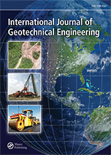
International Journal of Geotechnical Engineering
Advancing Geotechnical Knowledge for a Sustainable FutureThe International Journal of Geotechnical Engineering, published by Taylor & Francis Ltd, is a leading academic platform dedicated to advancing knowledge and research in the field of geotechnical engineering, environmental engineering, and soil science. With an ISSN of 1938-6362 and an E-ISSN of 1939-7879, this journal has established a credible presence since its inception in 2007, reflecting its commitment to academic excellence through rigorous peer-reviewed research. Ranking in the Q2 quartile across several categories—including Environmental Engineering and Geotechnical Engineering—this journal boasts impressive Scopus rankings, placing it among the top publications in its disciplines. The journal seeks to foster a deeper understanding of soil behavior, geotechnical processes, and their environmental impacts, making it an essential resource for researchers, professionals, and students alike. While it operates under a subscription model, the wealth of knowledge and innovative findings disseminated within its pages are indispensable for anyone engaged in this vital field. With an expanding focus on interdisciplinary research and practical applications, the International Journal of Geotechnical Engineering continues to play a pivotal role in shaping the future of engineering practices worldwide.

Transportation Infrastructure Geotechnology
Pioneering Research in Infrastructure Sustainability and Safety.Transportation Infrastructure Geotechnology, an esteemed journal published by SpringerNature, serves as a vital platform in the fields of Civil and Structural Engineering, Environmental Engineering, Geotechnical Engineering, and Transportation. Established in 2014 and spanning a decade of significant scientific discourse, this journal has gained recognition for its robust contribution to the understanding of the interplay between geotechnical processes and transportation infrastructure. With an impactful Q2 ranking in multiple categories—including Civil and Structural Engineering and Environmental Engineering—it emphasizes innovative research and practical applications globally. Researchers and professionals can explore critical topics that influence infrastructure sustainability, safety, and efficiency. Although it operates under a subscription model, its affiliation with SpringerNature ensures rigorous peer-review and high-quality publications, making it an indispensable resource for academics and industry experts alike.
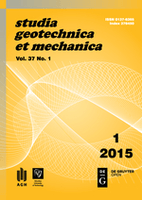
Studia Geotechnica et Mechanica
Innovating Civil Engineering Through Open Access ResearchStudia Geotechnica et Mechanica is a distinguished academic journal dedicated to the vital fields of geotechnics, civil engineering, and materials science. Published by SCIENDO, this Open Access journal has been facilitating unrestricted access to research since 2012, allowing for wide dissemination of innovative findings and methodologies. Based in Poland, it contributes significantly to the scholarly community by providing a platform for the exchange of ideas, techniques, and advancements relevant to Civil and Structural Engineering, Geotechnical Engineering, and related disciplines. With an increasing emphasis on applied research, Studia Geotechnica et Mechanica is classified in various quartiles, demonstrating its emerging influence in fields such as Computers in Earth Sciences and Mechanics of Materials. The journal is indexed in Scopus, showcasing its commitment to maintaining high academic standards. By publishing peer-reviewed research articles, this journal is essential for researchers, professionals, and students looking to stay at the forefront of developments in these critical areas of engineering and science.

Geotechnical and Geological Engineering
Pioneering Research for Tomorrow's Geotechnical ChallengesGeotechnical and Geological Engineering, published by SPRINGER, is a premier journal dedicated to advancing the field of geotechnical and geological engineering. With a strong reputation demonstrated by a robust impact factor and notable Scopus rankings, the journal positions itself in the top quartile of categories such as Architecture and Geotechnical Engineering, making it an essential resource for researchers and practitioners alike. Established in 1991 and continuing through 2024, it provides a platform for original research that addresses the pivotal challenges in soil science, geology, and engineering geology. Although it does not offer open access, it remains accessible through institutional and personal subscriptions, ensuring that academic scholars, industry professionals, and students can engage with high-quality, peer-reviewed content. The journal's commitment to disseminating innovative findings and fostering interdisciplinary dialogue underscores its vital role in shaping future developments in engineering and environmental sustainability.

CANADIAN GEOTECHNICAL JOURNAL
Pioneering Research in Soil Mechanics and Engineering GeologyCanadian Geotechnical Journal, published by Canadian Science Publishing, stands as a premier resource in the field of geotechnical engineering, focusing on the science and practice of soil mechanics, engineering geology, and related disciplines. Established in 1968, this esteemed journal has earned a distinguished reputation, holding a Q1 ranking in both Civil and Structural Engineering as well as Geotechnical Engineering and Engineering Geology as of 2023. It features a rigorous peer-review process that ensures the publication of high-quality research, making it essential reading for researchers, professionals, and students alike. With an impressive Scopus rank of #63 out of 379 in Civil and Structural Engineering and #41 out of 229 in Geotechnical Engineering, the journal continues to contribute significantly to the advancement of knowledge in geotechnics. While the journal does not currently provide open access options, it remains a vital platform for disseminating innovative findings and fostering academic collaboration in the geotechnical community.